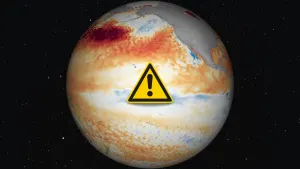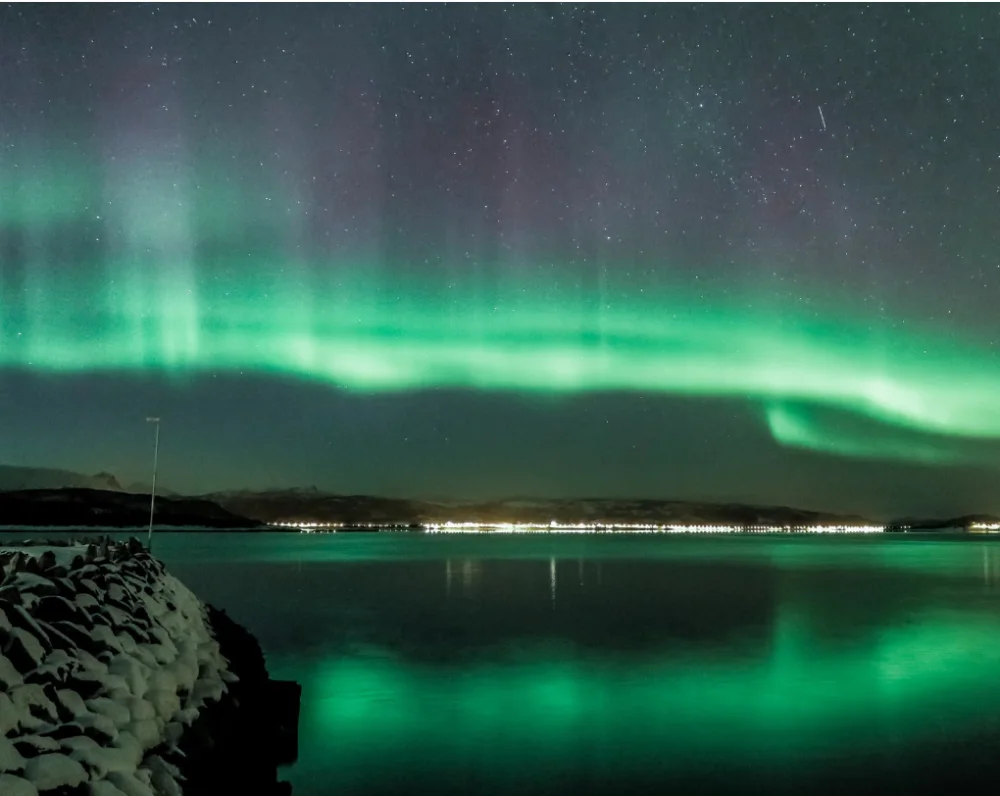
Look up for one more chance to see the Northern Lights
The hoped-for auroras failed to show up on Thursday night, but there may yet be a chance go see them on Friday night!
Space weather scientists and aurora chasers alike were taken by surprise in the early hours of Tuesday morning!
Even while they were waiting, hopeful, to see the Aurora Borealis in the latter half of this week, due to the expected arrival of two solar storms, the skies over Canada and the northern United States suddenly erupted in a bright display, a full two days earlier than anticipated!
On Monday night, while conditions started off fairly quiet, they did not stay that way. After midnight, something caused a sudden explosion of activity in Earth's geomagnetic field, sparking a moderate geomagnetic storm at first, which then escalated into a strong geomagnetic storm before conditions eventually settled down again.
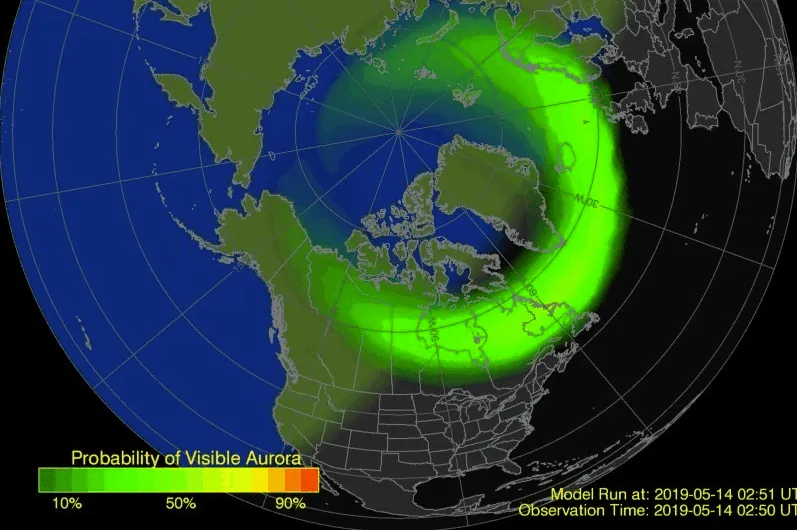
This animation shows the probability of seeing the Aurora on the night of May 13-14, 2019, across Canada and the United States. The sudden explosion of orange and red across the aurora oval shows the spike in geomagnetic activity, early Tuesday morning. Credit: NOAA SWPC
The result of all this activity was an intense display of the Aurora over Canada and the northern United States. It was even captured by orbiting satellies!
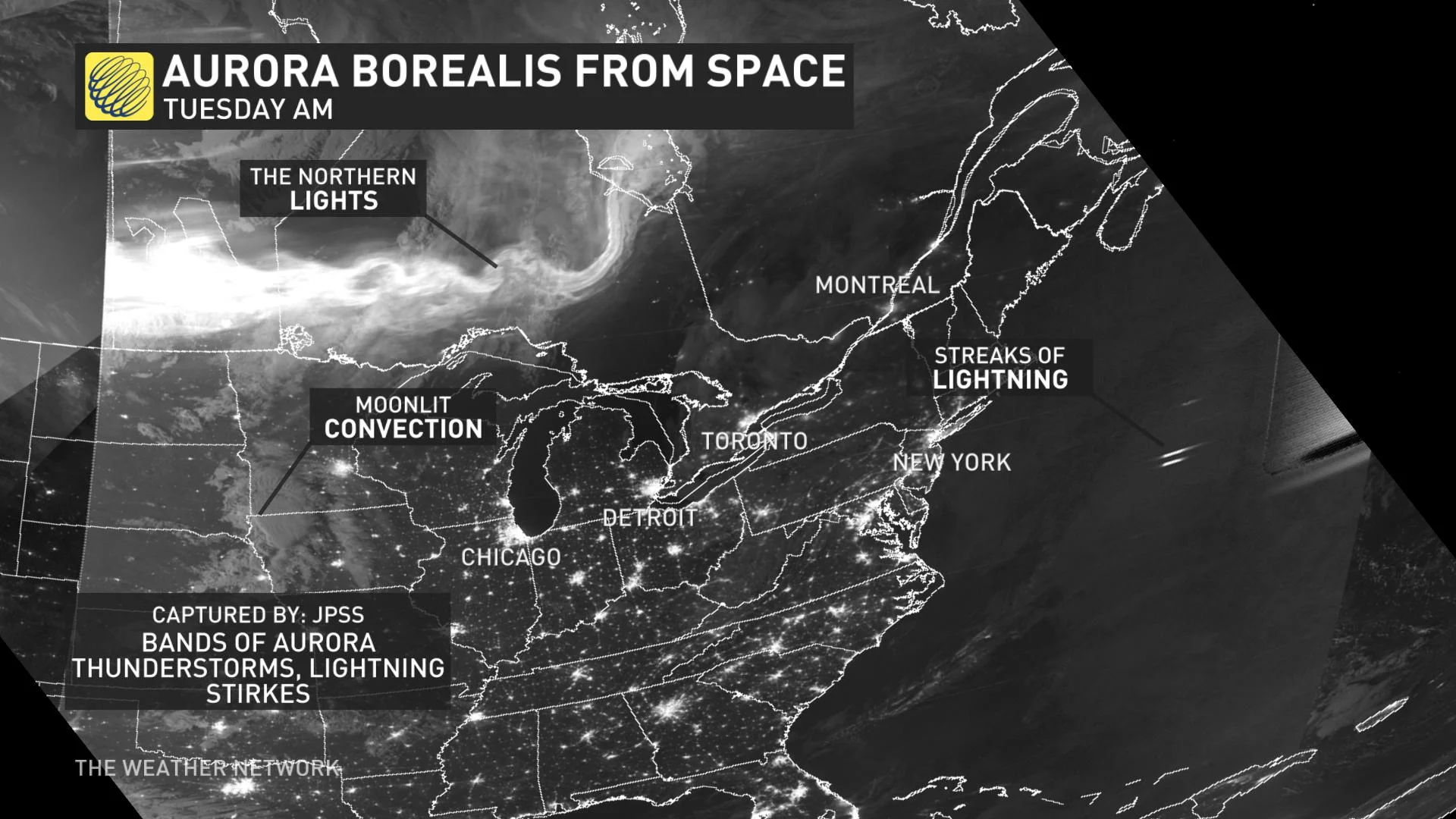
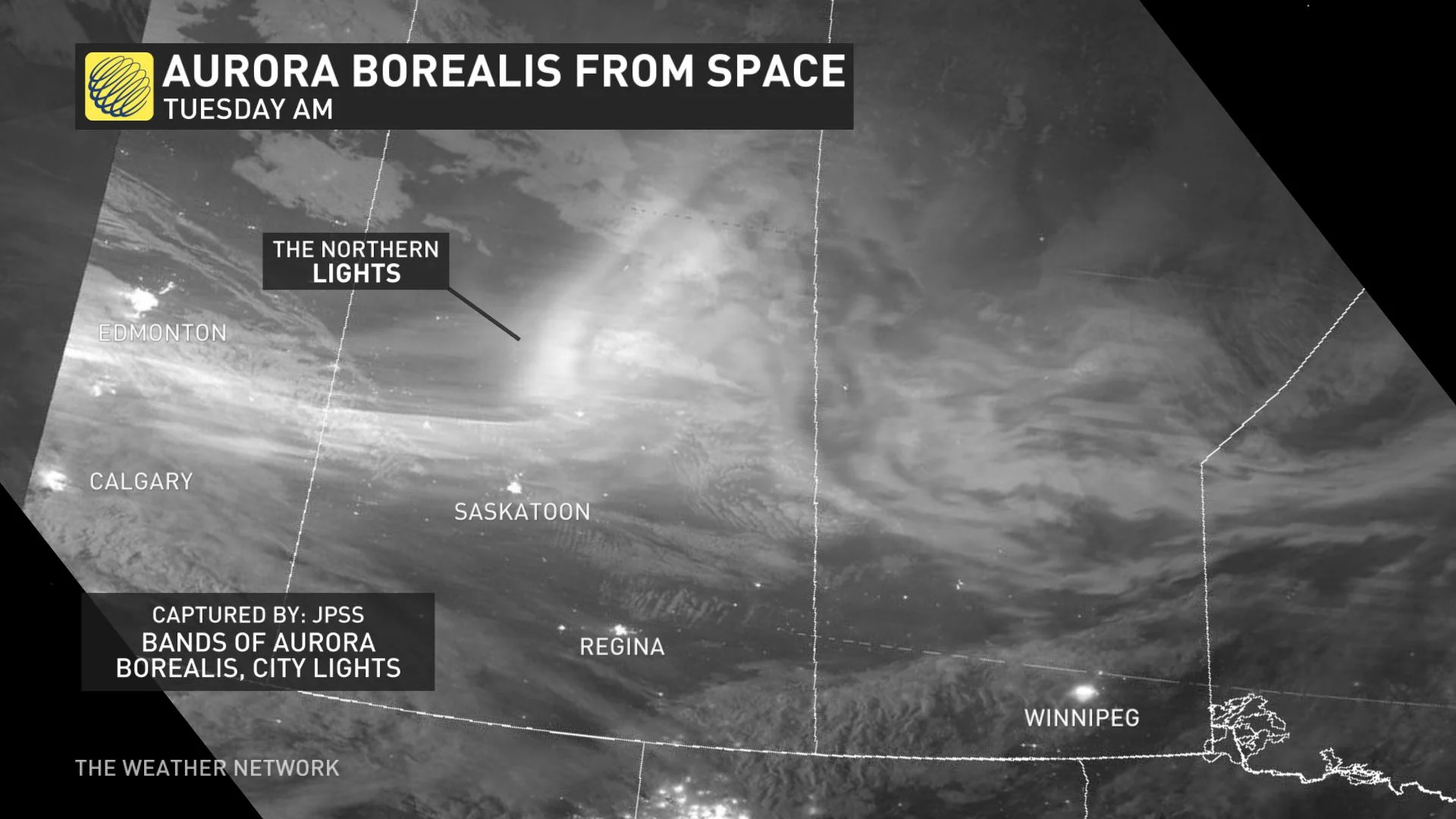
These two images were captured by the NOAA-20 polar orbiting satellite, using a special instrument that is sensitive enough to pick up lights on the night side of Earth. Visible are city lights, cloud tops (including some moonlit convective clouds over the Midwest), and a long, bright swath of the Northern Lights, stretching from northern Quebec to across the Prairies.
NOAA-20 also captured this high-resolution look at the aurora as the satellite passed over the Great Lakes.
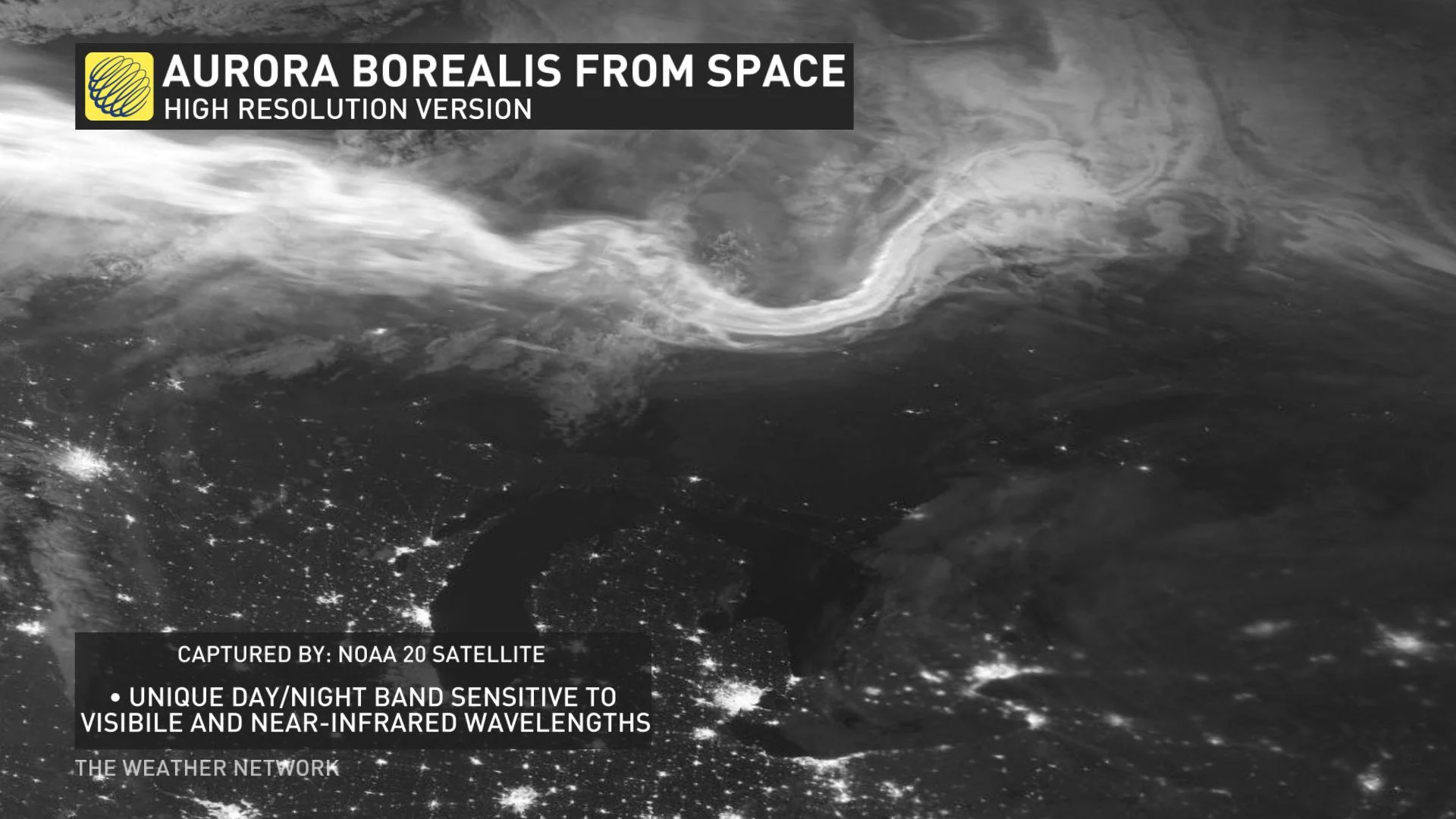
It was also seen by vigilant aurora spotters on the ground, such as Bruce McCurdy, in Edmonton, AB.
It was visible in northern Michigan, as well, as shown by this short video recorded by Isaac (@ID_Photo_Graphy) from Keweenaw Peninsula.
AN ENCORE?
As unexpected as Tuesday morning's geomagnetic storm was, it was a very welcome surprise!
Not only did it provide an amazing display of lights for anyone with clear skies at the time, but it is also expected to enhance whatever activity occurs due to the arrival of two solar storms!
NOAA SWPC's latest forecast, which originally included the potential for a minor (G1) geomagnetic storm on Wednesday, Thursday and Friday, was upgraded for expected moderate (G2) geomagnetic storm levels on Thursday, May 16!
Unfortunately, while space weather conditions did briefly reach minor and close to moderate storm levels at a few points during the afternoon and early evening on Thursday (with respect to North American timezones), they did not apparently persist long enough to spark off an actual geomagnetic storm.

*The Disturbance Storm Time index is a measure of Earth's geomagnetic activity. The lower the value, the more energy is stored in Earth's magnetosphere, and thus the greater the chance of there being a geomagnetic storm, and aurora activity. Credit: SpaceWeatherLive.com
SO, WHAT HAPPENED?
So, there was a little bit of hype going around about these solar storms and the potential to see auroras, even in the most southern parts of Canada, and yet it appears as though - beyond the unexpected activity on Tuesday morning - nothing much happened.
This isn't the first time we've been disappointed, so, what happened?
When space weather scientists spotted the solar storms being launched out into space a week ago, they noted that the two were headed more or less directly at Earth. They modelled the progress of the storms, based on their initial observations of size, speed, and density. There was one major limitation, however. They would not get any more real data until the storms swept past the various satellites stationed at Lagrange Point 1, just hours before the clouds of plasma would pass Earth.
Terrestrial weather forecasters have the advantage of continually updated weather data from ground stations, weather balloons and satellite observations. Rarely do we go more than 6 hours without an update of how the weather is evolving over time.
Space weather forecasters, on the other hand, go days between updates.
Couple this with the fact that actually seeing auroras develop from solar activity takes very specific conditions, though, and if the solar storms don't meet those conditions, nothing will happen.
Based on satellite data and measurements from Earth, it appears as though these solar storms only caused brief distbances to the planet's magnetic field. Perhaps if they had been travelling faster, or if they had a stronger magnetic field, we would have seen more activity from them.
According to NOAA's Space Weather Prediction Center, there is still a chance of a brief minor (G1) geomagnetic storm on Friday night.
Visibility for any auroras that do develop will likely be restricted to northern Quebec and Ontario, and across the central Prairie provinces.
WHAT'S GOING ON HERE?
There is plenty of terminology being thrown around here. Geomagnetic storm. Solar storm. Coronal Mass Ejection. Solar wind. Planetary K-index. So, let's break this down.
Earth is surrounded by a "protective bubble" of magnetic force, known as the 'planetary geomagnetic field'. It is produced by the churning, ionized iron circulating around in the planet's liquid outer core, and it extends far out into space.

Earth's geomagnetic field diverts high-energy solar particles in the solar wind around the planet. Credit: NASA Goddard Scientific Visualization Studio
As Earth travels in its orbit, it passes through a constant flow of charged particles that originate from the Sun, known as the 'solar wind'. Different streams in the solar wind, fast or slow, have different effects on Earth's geomagnetic field. Normally, the solar wind particles are simply diverted around the planet. Sometimes, though, particles can slip through, get caught up along the field lines, and stream down towards the poles.
When these high-energy particles hit the molecules of air in the upper atmosphere, they transfer some of their energy, which forces the molecules to emit light. This is what we call the Aurora Borealis or Northern Lights (or the Aurora Australis or Southern Lights, around the south pole).
All of this activity is recorded by satellites and observed from the ground, and based on all of that, a number is assigned to the level of activity. This is the 'Planetary K-index' (Kp), which ranks from 0 to 9, and is a measure of the activity over the past three hours.
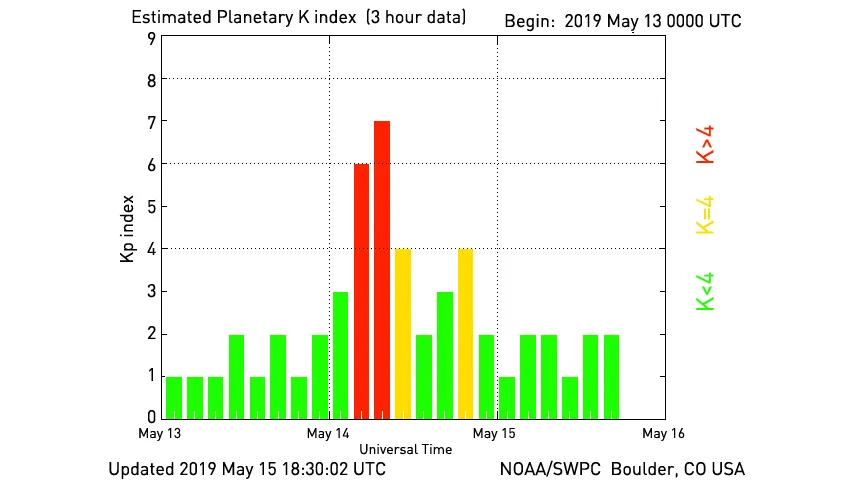
The Planetary K-index values for May 13, 14 and 15 reveal the sudden spike in geomagnetic activity early on Tuesday. Anything below Kp=5 is considered 'sub-storm' levels, when auroras are not expected to extend very far south (at least not for any extended length of time). Kp=5 is a G1 (minor) storm, Kp=6 is a G2 (moderate) storm, and Kp=7 is a G3 (strong) geomagnetic storm. Credit: NOAA SWPC
The higher the number, the brighter the auroras are, and the farther south they expand.
When the Kp values reach 5 or higher, forecasters call it a 'geomagnetic storm', and there are five levels of storm from a 'minor' G1 (Kp=5) to the 'extreme' G5 (Kp=9).
Note: because the Kp value is an average over three hours, it may not reflect all of the activity happening. Some observers have noted brief bursts of bright auroras, even when the Kp value is less than 5 ('substorm' levels). For this reason, Kp shouldn't be used to predict when you go out aurora spotting, but only as a measure of how strong it was, after the fact.
Occasionally, usually due to an explosion of energy from the Sun's surface known as a 'solar flare', a huge cloud of plasma can erupt out into space. These clouds are technically called 'coronal mass ejections' or CMEs, but 'solar storm' is also used. They expand outwards from the solar flare location, as a ripple of denser plasma passing through the solar wind, carrying its own magnetic field as it moves along.
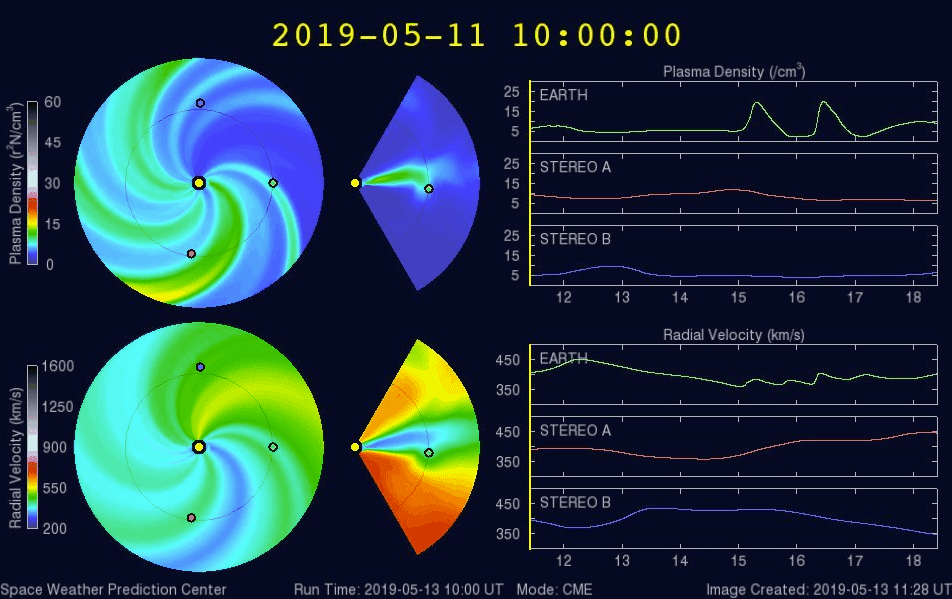
This forecast model from NOAA shows the solar wind conditions in the inner solar system for this week. The solar wind is represented by the pinwheel-like flows of lighter (denser/slower) shows two CMEs emitted by the Sun on the night of Friday, May 10, as they sweep outwards and pass by Earth - the first on May 15, and the second on May 16. Credit: NOAA SWPC
If one of these CMEs sweeps past Earth, the sudden interaction between its magnetic field and Earth's geomagnetic field produces a reaction, a bit like striking a gong. The denser, faster and/or more energetic the CME is, the stronger the reaction (beware the CME that is dense, fast AND energetic!).
This causes Earth's magnetic field to become very active, shifting and fluxing, which allows many of the particles from the CME to be captured along the field lines, to stream down into the atmosphere to produce auroras. The more particles that slip in, the brighter the auroras appear, and the farther south we tend to see them.
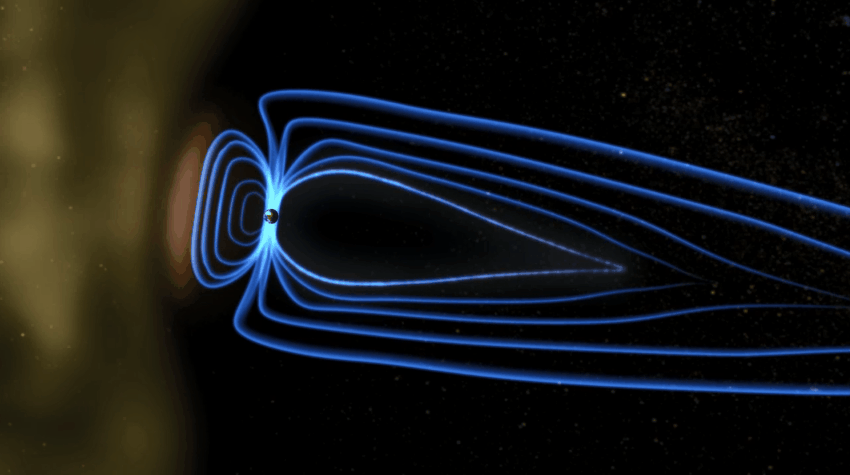
This animation shows the effects of the solar wind and coronal mass ejections on Earth's geomagnetic field, and how this results in auroras. Credit: NASA GSVS
Additionally, solar storms have been known to enhance each other.
This can be out in interplanetary space, such as when a faster moving CME catches up to a slower moving one, and they merge into a denser one that ultimately has a stronger impact when it reaches Earth. Such a combination of CMEs was spotted in the summer of 2012, which would have put us at risk of a global blackout, had the resulting faster and denser CME impacted Earth at the time. Fortunately, it was aimed far enough ahead of us in our orbit, that we were only affected by the trailing end, rather than a direct hit.
As we are seeing now, this enhancement can can come from multiple disturbances to Earth's geomagnetic field in a short amount of time.
According to Michael Cook (@SpaceWxMike), Space Weather Forecaster Lead at Apogee Engineering, the arrival of one CME can "rattle" Earth's geomagnetic field, "leading to favorable conditions when the other CMEs arrive."
Sources: NOAA | CIMSS/SSEC/UW-Madison | Spaceweather.com | With files from The Weather Network








